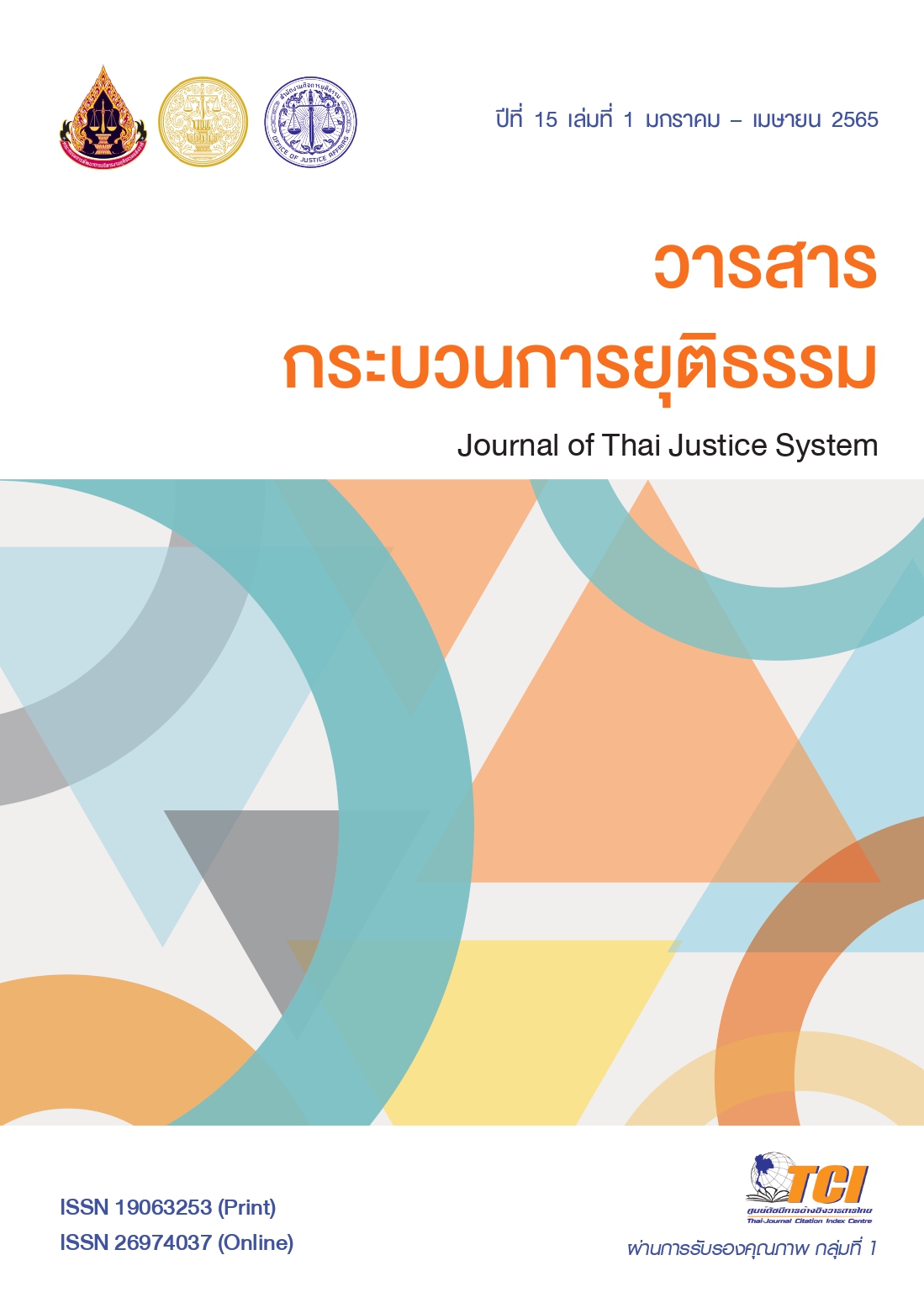ความเปลี่ยนแปลงของโทษประหารชีวิตในพระราชกฤษฎีกาพระราชทานอภัยโทษ
Main Article Content
บทคัดย่อ
ในอดีตที่ผ่านมาประเทศไทยได้มีการพระราชทานอภัยโทษให้แก่นักโทษที่ถูกศาลตัดสินว่าเป็นผู้กระทำความผิดตลอดมาตามแต่ในวโรกาสที่สำคัญของพระมหากษัตริย์ โดยการพระราชทานการอภัยโทษนั้นอาจเป็นการปล่อยตัวให้แก่นักโทษ การลดโทษหรือการเปลี่ยนโทษหนักเป็นเบาให้แก่ผู้กระทำความผิดในทางอาญา ซึ่งในอดีตที่ผ่านมานักโทษที่ต้องโทษประหารชีวิตนั้นสามารถที่จะได้รับการพระราชทานอภัยโทษจำนวนกี่ครั้งก็ได้เนื่องจากในพระราชกฤษฎีกาพระราชทานอภัยโทษมิได้กำหนดห้ามไว้ แต่เมื่อไม่นานมานี้ได้มีพระราชกฤษฎีกาพระราชทานอภัยโทษ พ.ศ. 2562 ซึ่งออกมาเนื่องในโอกาสมหามงคลพระราชพิธีบรมราชาภิเษก และพระราชกฤษฎีกาพระราชทานอภัยโทษ พ.ศ. 2563 ที่ได้ออกมาเนื่องในโอกาสวันเฉลิมพระชนมพรรษาพระบาทสมเด็จพระเจ้าอยู่หัว ได้มีการบัญญัติมาตรา 13 (1) ขึ้นมาเพื่อจำกัดสิทธิในการได้รับการพระราชทานอภัยโทษของนักโทษที่ต้องโทษประหารชีวิต บทความนี้จึงได้มุ่งทำการศึกษาถึงความเปลี่ยนแปลงของพระราชกฤษฎีกาพระราชทานอภัยโทษในส่วนที่มีความเปลี่ยนแปลงที่เกี่ยวข้องกับโทษประหารชีวิต และศึกษาถึงความเปลี่ยนแปลงดังกล่าวว่าได้มีผลต่อผู้ต้องโทษประหารชีวิตในกรณีการได้รับประโยชน์ตอบแทนความประพฤติดีของผู้ต้องขังของกรมราชทัณฑ์หรือไม่อย่างไร ซึ่งจากการศึกษาพบว่าการเปลี่ยนแปลงของโทษประหารชีวิตในพระราชกฤษฎีกาพระราชทานอภัยโทษนี้ เป็นการเปลี่ยนแปลงที่ส่งผลให้ผู้ต้องโทษประหารชีวิตที่ได้รับการพระราชทานอภัยโทษแล้วครั้งหนึ่ง ไม่สามารถได้รับพระราชทานอภัยโทษตามพระราชกฤษฎีกาได้อีก อันเป็นการทำให้นักโทษเด็ดขาดซึ่งต้องโทษประหารชีวิตที่ได้รับการพระราชทานอภัยโทษเป็นโทษจำคุกตลอดชีวิตนั้นได้รับโทษจำคุกที่ยาวนานขึ้น ไม่สามารถถูกปล่อยออกจากเรือนจำได้เร็วกว่าโทษที่กำหนดไว้มากเกินไปดังที่ประเทศไทยเคยเป็นมา อีกทั้งความเปลี่ยนแปลงดังกล่าวยังคงมีความสัมพันธ์กับการให้ประโยชน์ตอบแทนความประพฤติดีของผู้ต้องขังในกรณีพักการลงโทษและการลดวันต้องโทษ ในประเด็นที่ว่า เมื่อนักโทษเด็ดขาดซึ่งต้องโทษประหารชีวิตที่ได้รับการพระราชทานอภัยโทษไปแล้วนั้น อาจจะยังคงสามารถได้รับการพักการลงโทษและการลดวันต้องโทษอยู่เช่นเดิมหากมีลักษณะที่เป็นไปตามหลักเกณฑ์ของกรมราชทัณฑ์ ดังนั้น การที่จะทำให้ความเปลี่ยนแปลงเกี่ยวกับโทษประหารชีวิต ในพระราชกฤษฎีกานี้มีประสิทธิภาพและประสิทธิผลมากขึ้น เพื่อให้ผู้ต้องโทษได้รับการลงโทษที่เหมาะสมกับการกระทำความผิดนั้น มีความจำเป็นที่จะต้องมีการแก้ไขประมวลวิธีพิจารณาความอาญาในส่วนที่เกี่ยวกับการอภัยโทษต่อไป
Article Details

อนุญาตภายใต้เงื่อนไข Creative Commons Attribution-NonCommercial-NoDerivatives 4.0 International License.
ต้นฉบับที่ได้รับการตีพิมพ์ในวารสาร เป็นลิขสิทธิ์ของวารสารกระบวนการยุติธรรม แต่ความคิดเห็นที่ปรากฏในเนื้อหาของบทความในวารสารกระบวนการยุติธรรม ถือเป็นความรับผิดชอบของผู้เขียนแต่เพียงผู้เดียว
เอกสารอ้างอิง
กรมราชทัณฑ์. (2552). คู่มือการขอพระราชทานอภัยโทษ (พิมพ์ครั้งที่ 2 แก้ไขและเพิ่มเติม). นนทบุรี: ผู้แต่ง.
กรมราชทัณฑ์. (2564). รายงานสถิตินักโทษประหารชีวิตกรมราชทัณฑ์. ค้นเมื่อ 1 กุมภาพันธ์ 2564, จาก http://www.correct.go.th/executed/index.php
นฤมล นิราทร. (2559). การเปลี่ยนแปลงทางสังคมและปัญหาสังคม. กรุงเทพฯ: สำนักพิมพ์มหาวิทยาลัยธรรมศาสตร์.
พรเลิศ ศักดิ์สงวนมนูญ. (2555). อำนาจในการพิจารณาพักการลงโทษ. วิทยานิพนธ์นิติศาสตรมหาบัณฑิต. มหาวิทยาลัยธรรมศาสตร์.
สมบูรณ์ เตชะวงศ์. (2555). พระราชทานอภัยโทษ. กรุงเทพฯ: อนิเมทกรุ๊ป.
สุรศักดิ์ ลิขสิทธิ์วัฒนกุล. (2549). พระราชอำนาจในการพระราชทานอภัยโทษ. กรุงเทพฯ: มหาวิทยาลัยธรรมศาสตร์.
สูตรไพศาล. (ม.ป.ป.). พระราชบัญญัติพระราชทานอภัยโทษ นิรโทษกรรม และล้างมลทินฯ. กรุงเทพฯ: ผู้แต่ง.
สำนักงานคณะกรรมการกฤษฎีกา. นิรโทษกรรม อภัยโทษ ล้างมลทิน ความร่วมมือระหว่างประเทศในกระบวนการยุติธรรม สัญชาติ องค์การระหว่างประเทศ. ค้นเมื่อ 16 พฤศจิกายน 2563, จาก https://www.krisdika.go.th/data/ebook/thailaw/thailaw54.pdf


